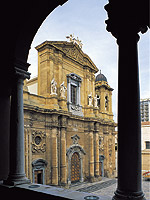
What to visit - Marsala
Archaeology, Baroque and liberty style: that is what to see in Marsala The historical centre – Coming in from Garibaldi Gate, on the right side you will find the market of fish, that every morning is full of sellers and buyers and the sixteenth-century Spanish Quarter, nowadays seat of the town hall. Instead, on the left, a little square embellished by the elegant face of the Santuario dell’Addolorata (Sanctuary of Our Lady of Sorrows), opens. Further on, the street ends in the main square of the historical centre where Palazzo VII Aprile (VII of April Mansion) and the main Church overlooks. This last, consecrated to St Thomas of Canterbury, dominates the square with its seventeenth-century two-orders face. Inside, in the many sides-chapels, sculpture works and important paintings are preserved. At the back of this, the auditorium Santa Cecilia, also this remarkable for the rich decorations of the Baroque face. Not far from there the Complesso San Pietro ( St Peter Unit), a sixteenth-century monastery, nowadays a cultural centre that lodges inside also the Civic Museum with the Garibaldi section. Very particular is the tiled dome, also visible from via XI Maggio (XI of May street), the fulcrum of modern town life and night amusements. If you are there or in its continuation, via Roma, every now and then look up: both of them are surrounded by liberty style affected and refined mansions. The Stagnone lagoon – An expanse of closed and protected sea, declared Natural Reserve, offers to visitors an unequalled spectacle. Here it is also situated the small island of Mothia, the ancient vital nucleus of the area. And a little further on, you will find the tanks for salt picking.
Behind the windmills, every evening the sun sets giving shivering landscapes. Baglio Anselmi Archaeological Museum – A last century wine factory is today seat of the museum that preserves the archaeological finds discovered during the several archaeological excavations campaigns between Marsala and Mothia. It is a considerable collecting of pottery, amphorae, funerary furnitures, votive steles, furnishings and jewels, architectural features and objects of every kind. Here it is also preserved a splendid mosaic coming from the Roman island. The museum also boasts the presence of the Callipigia Venus and of the Punic ship. The Callipigia Venus, recently recovered, though limbs and head lacking, attracts immediately the attention of the visitor on its soft and elegant figure and on its drapery that, instead of covering it, shows off its nudity. The Punic Ship is a remarkable testimony of the ancient wars that Romans and Carthaginians fought in these waters. Probably the wreck sank during the battle of the Egadi that in 241 B.C. ended the I Punic war. The shp has been rebuilt inside the museum: you may see the larboard side and the part of the stern. Together with the ship, also part of the shipload has been got back. Where: Baglio Anselmi Archaeological Museum - Lungomare Boeo
When: from 9.00 a.m to 06.00 p.m every day
3 € ticket
2 € reduced ticket
Free entrance for visitors under 18 year and over 65 years.
|

